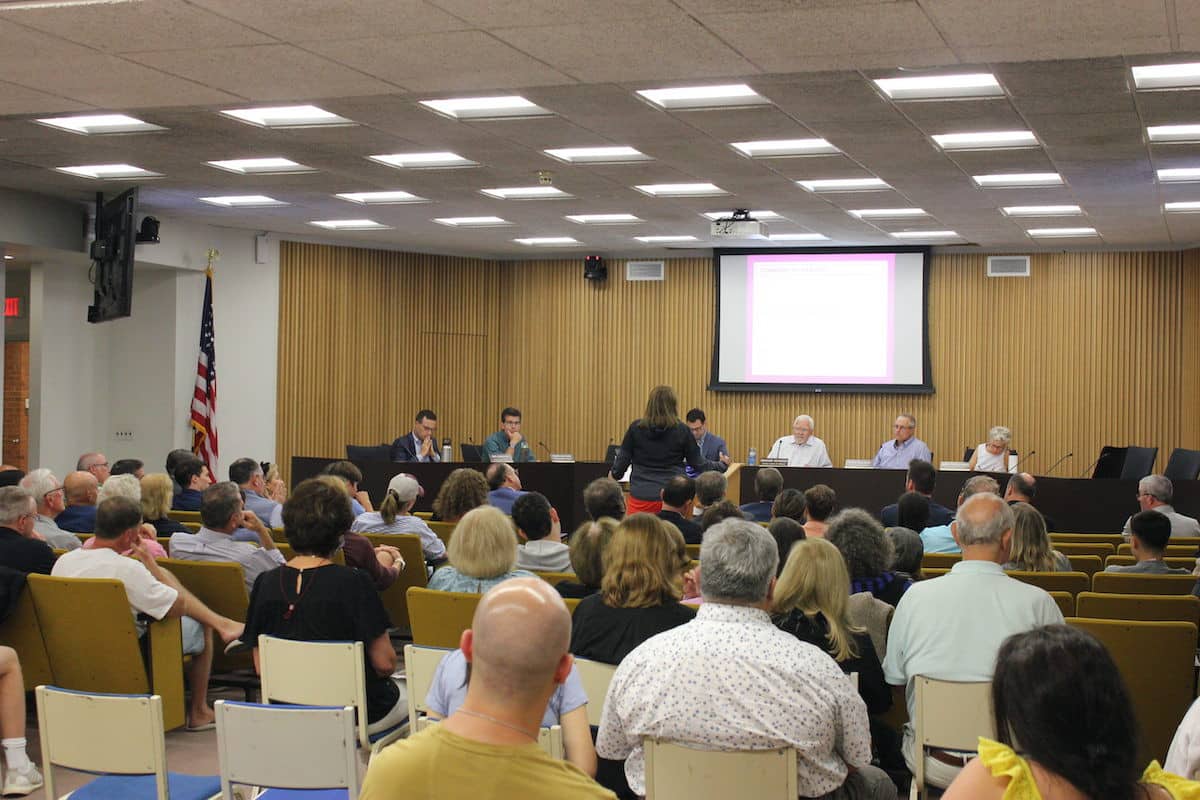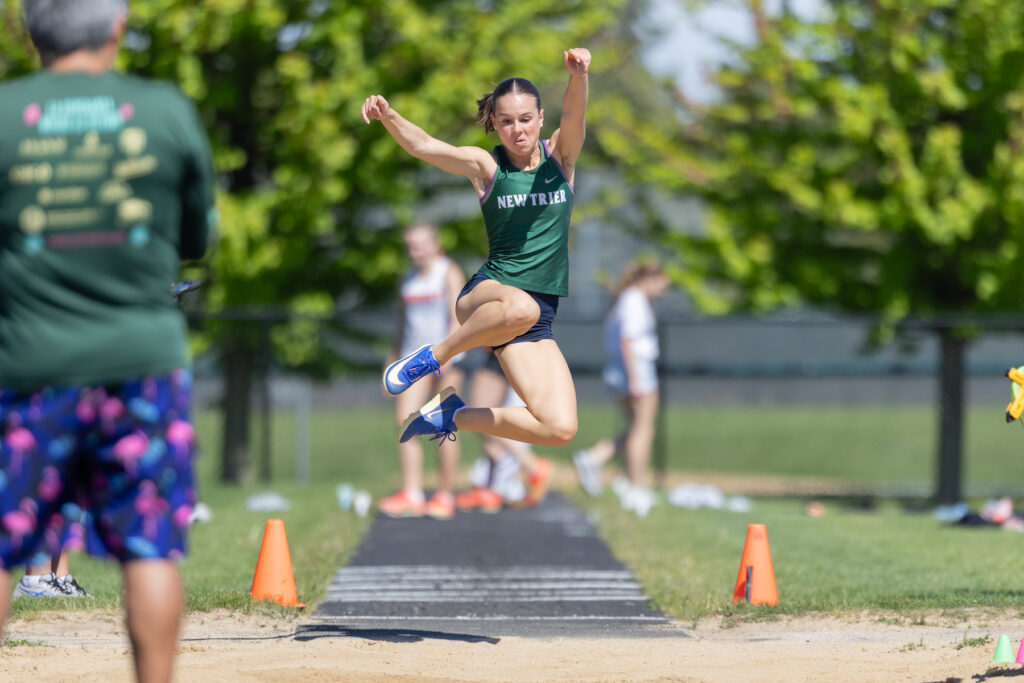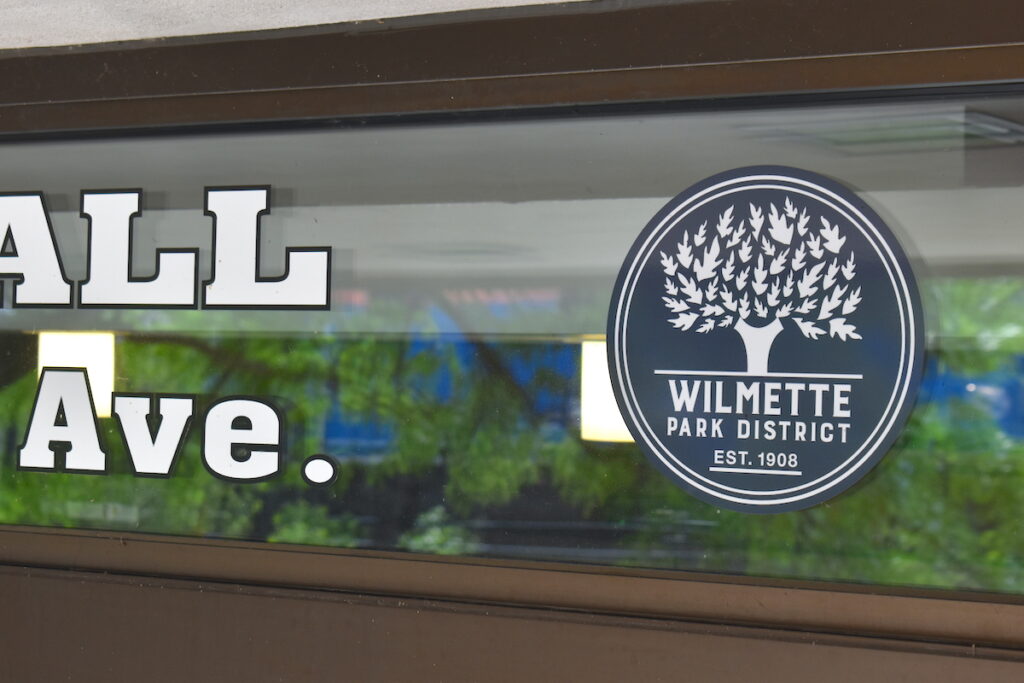
Zoning board goes into overtime discussing Loyola lights proposal; Meeting to continue at later date
Mix of supporters, objectors fill council chambers for four-hour meeting
Loyola Academy has endured plenty of hard-fought battles at the intersection of Lake and Laramie avenues, but the Wilmette private high school could be in for its toughest fight to date as it attempts to advance plans to install stadium lights on its campus.
Representatives from Loyola, along with several consultants commissioned by the school, presented their proposal to install four, 80-foot light poles — two on each side of Hoerster Field — at Sachs Stadium on Thursday, Sept. 6, during a meeting of the Wilmette Zoning Board of Appeals.
After just over four hours of deliberation, zoning commissioners opted to extend the public hearing on the matter to a second meeting, which could be held in mid-October at the earliest, officials said.
Approximately three hours of the Sept. 6 meeting were devoted to Loyola’s presentation. Before opening public comment, Zoning Board Chair Reinhard Schneider announced that commissioners would continue the meeting until 11 p.m., leaving roughly one hour for commenters to address the board.
Loyola officials and consultants spent the majority of their presentation attempting to address what the school describes as “perceived impacts of the athletic field lighting and its planned seasonal usage.”
In their proposal to the Village of Wilmette, Loyola officials listed five “areas of concern” of local residents identified through their community engagement process: traffic and parking impacts, noise, safety and security, light distribution, and the impact of adding stadium lighting on property values.
A significant portion of Loyola’s presentation focused on the school’s traffic management plan as officials detailed mitigation strategies. They include off-site parking options — such as utilizing parking lots at nearby institutions like New Trier’s Northfield campus and Regina Dominican High School — increased fines for parking violations on nearby streets, designating portions of the school’s lot for carpool vehicles, and heightened enforcement of local parking and traffic regulations.
Commissioners questioned the feasibility of some of the proposed options, mostly highlighting concerns regarding enforcement and execution of Loyola’s parking mitigation plans.
Noise levels were also a topic discussed at length. Dr. Thomas Thunder, of Acoustic Associates, presented on behalf of Loyola and argued that football games hosted on Friday nights would pose no long-term health impact on nearby residents.
Additionally, a noise study conducted by Acoustic Associates included in the school’s proposal, estimated that that noise created from regular-attendance home games would be “just noticeable” over the ambient noise produced by neighboring Edens Expressway. The study based the estimation on 2007 sound data taken from a highly attended football game in Oak Park.
During their pitch to the board, Loyola officials also argued that its state-of-the-art lighting technology will control spillage and glare, and that the school is committed to requesting police officers and increased personnel to control security.

Why now?
Loyola’s proposal to install stadium lights at its Wilmette campus stems from an “increase” in participation in athletics and the need to extend the field usage in the stadium,” said Genevieve Atwood, Loyola Academy’s vice president for athletics and fitness.
Atwood added that Loyola’s athletics facilities cannot currently accommodate all of the school’s teams, which she said leads to the Ramblers’ programs having to go “offsite to outdoor and indoor fields, causing many challenges for both our athletes and our coaches and our families.”
According to Atwood, Loyola has more than 1,400 student-athletes and 75 athletics teams.
Loyola is proposing to utilize the stadium lights for up to 60 nights per year, broken up into a maximum of five Friday football games (10:30 p.m. curfew), 30 practices (7 p.m.) and 25 nonfootball (lacrosse, soccer, track and field) competitions (9 p.m.).
School officials said at the meeting that the lighted field would only be used by Loyola students and student-athletes, and under the proposal could not be rented out for third-party events, including concerts.
The Record first reported in December 2022 that Loyola was preparing to formally seek stadium lights, collecting donations in its Champions Campaign that marketed the lights and letting the Village of Wilmette know of its intentions. The Record also detailed Loyola’s proposal last week when the school finalized its proposal.
“Simply put, we are looking to enhance the student, the athletic and the community experience at Loyola Academy with lights at our Wilmette campus,” said Marty Jennings, advancement chief of staff at Loyola.
As it relates to football, Atwood said that Loyola has seen “declining attendance” at Saturday home games.
“We’re a commuter school, where students come from all over the city and suburbs … and we think the Friday night experience will be a great community event not only for Loyola Academy but for the wider Wilmette community.”
Atwood also highlighted the school’s belief that several athletic programs, and not just football, will benefit from lights.
“I’m convinced lights will impact our student-athletes and our community positively,” she said. “This will provide equity to all of our sports teams and opportunities for men’s and women’s sports to compete on campus in front of our peers.
“We are making this request for the installation of lights so that the Loyola Academy community, our student-athletes and their families can enjoy the same opportunities that the local public schools and private schools have across the state.”
Loyola’s request is a ‘betrayal of trust,’ neighbors say

Opposition to lights at Loyola’s stadium by nearby residents has been brewing for months, forming prior to the school’s zoning application filed earlier this year.
Concerns regarding traffic and parking congestion, noise and light pollution, and community safety highlight residents’ objection. Some residents even launched a website, No Loyola Lights, to formally organize their discontent.
More than 100 locals packed Wilmette Village Hall to attend the meeting. Due to the time limit on the meeting set forth by the board, only 14 members of the audience could address commissioners during public comment.
Approximately 30 locals indicated a desire to speak when Schneider polled the audience before commencing public comment. He assured residents who weren’t able to speak at the Sept. 6 meeting that they will have the opportunity to do so at the next meeting.
The majority of commenters shared their disapproval of the school’s plan, but a few speakers did express their support for Loyola’s plans.
John Dwyer, who is the longtime coach of Loyola Academy’s girls lacrosse team, urged the board to consider how adding lights will positively impact other programs aside from just football
“We can’t host a state championship game; we’ve played in the state championship 19 times and we can’t host it because we can’t have lights and the IHSA doesn’t permit it,” the Winnetka resident said. “There’s been a lot of time and a lot of talk about the five nights of football games and that’s really important but you should also consider the 1,000-plus students at Loyola who don’t play football and play other sports, particularly women’s sports.”
Wilmette resident Anthony Scattone argued that “Loyola is truly an asset not only to the community but to families,” adding his belief that the nearby Edens Expressway is the detractor to nearby homes, not Loyola.
Plenty of contention from locals also came forward at the meeting.
Patrick O’Gara — a Wilmette resident who is an advocate for west Wilmette residents and has continually voiced opposition to the expansion of nearby West Park’s paddle tennis facilities — said approval of Loyola’s request would “permanently damage this neighborhood.”
“There is a limit to what one neighborhood can be told to live with before the idea of maintaining consistent community development and zoning standards in Wilmette becomes a joke,” he said. “ … This neighborhood has no capacity left for disturbance or more burdens, whether to do with Loyola Academy, or with West Park or with the Edens Expressway. It’s more than at its limit.”
Resident Lynn Wilk, who lives on the nearby New Trier Court, contested the minimal noise impact that Loyola’s study suggested would occur and noted concerns about traffic and exit procedures. She also compared the request to Northwestern University’s plans for expansion at Ryan Field, urging the board to consider this similarly.
“I think our neighborhood is extremely happy that the board of trustees is fighting the valiant fight so aggressively to stop Evanston and Northwestern from imposing the traffic and the noise and the devastation for the change at Ryan Field and I certainly hope that you and the board of trustees will fight just as strongly for the people in west Wilmette to stop this invasion of our neighborhood,” she said.
Lisa Crowe, who lives one block from Loyola on Branch Road, said she can hear “every whistle, every cheer and every band instrument” during Saturday home games, also stating that the village’s zoning limits on noise should apply to all of Wilmette.
“This is about our quality of life,” she said. “Nothing like this has ever happened in Wilmette nor should it. There is no amount of Loyola concessions that will get our west Wilmette neighborhood to accept this unprecedented increase from 45 to 94 decibels (the variation requested by Loyola Academy) at games at 10:30 at night when we’re trying to sleep or rest.”
Crowe concluded by saying, “these variance requests represent Loyola Academy’s total betrayal of our trust. I join all my neighbors in urging this board to give a hard no to Loyola’s zoning appeal.”
Zoning commissioners did not set an exact date for the second meeting that will continue the board’s public hearing; however, Oct. 11 was discussed as a potential option. Two commissioners, Bradley Falkof and Christine Norrick, were not present at the meeting.
It is standard practice for the zoning board to share its views on a proposal after public comment is closed. Because public comment was not completed at the Sept. 6 meeting, commissioners did not express their thoughts on Loyola’s proposal.
The Record is a nonprofit, nonpartisan community newsroom that relies on reader support to fuel its independent local journalism.
Become a member of The Record to fund responsible news coverage for your community.
Already a member? You can make a tax-deductible donation at any time.

Martin Carlino
Martin Carlino is a co-founder and the senior editor who assigns and edits The Record stories, while also bylining articles every week. Martin is an experienced and award-winning education reporter who was the editor of The Northbrook Tower.


